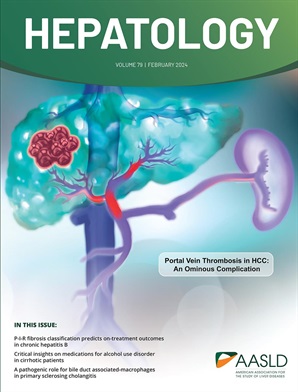肝硬化患者轻度腹水的预后意义
IF 12.9
1区 医学
Q1 GASTROENTEROLOGY & HEPATOLOGY
引用次数: 0
摘要
背景:显性(临床可检测)腹水是肝硬化中最常见的失代偿事件,并与高死亡率相关。轻度腹水的影响(仅通过影像学检测)尚不清楚。方法:对肝硬化患者进行回顾性队列研究,采用退伍军人肝病预后和相关费用(VOCAL)队列。使用自然语言处理对肝硬化诊断时的影像学报告进行分析,并将其分为三组:无腹水、1级(G1)或轻度腹水和2/3级(G2/G3)或明显腹水。采用Kaplan-Meier法和多变量Cox比例风险分析比较各组死亡率。结果:共纳入41669例患者:无腹水28628例(68.7%),G1型4046例(9.7%),G2/G3型6268例(15.0%)。中位随访时间为7.7年(IQR为5.1 ~ 10.6)。G1(轻度)腹水患者的中位生存期为3.9年(IQR 1.8-8.3),显著低于无腹水患者的中位生存期(6.5年;IQR 3.1-12.2, p<0.0001),但显著高于G2/G3腹水组(3.5年;IQR 1.5-7.9, p<0.0001)。在对潜在混杂因素进行调整后,存在任何级别的腹水都与较高的死亡风险相关:G1级腹水(HR 1.50;95% CI 1.44-1.57, p<0.001)和G2/G3腹水(HR 1.63;95% CI 1.57-1.69, p<0.001)。这些结果在多个敏感性分析中是一致的。结论:与无腹水相比,1级(轻度或亚临床)腹水与较差的生存相关,并且代表代偿性和失代偿性肝硬化之间的中间预后阶段。本文章由计算机程序翻译,如有差异,请以英文原文为准。
Prognostic significance of mild ascites in patients with cirrhosis
Background: Overt (clinically detectable) ascites is the most common decompensating event in cirrhosis and is associated with a high mortality. The impact of mild ascites (only detectable by imaging) remains unclear. Methods: Retrospective cohort study in patients with cirrhosis using the Veterans Outcomes and Costs Associated with Liver Disease (VOCAL) cohort. Imaging reports at time of diagnosis of cirrhosis were analyzed using natural language processing and classified in three groups: no ascites, grade 1 (G1) or mild ascites, and grade 2/3 (G2/G3) or overt ascites. Mortality was compared across the groups using the Kaplan-Meier method and multivariable Cox proportional hazards analysis. Results: 41,669 patients were included in the study: 28,628 (68.7%) without ascites, 4,046 (9.7%) with G1, and 6,268 (15.0%) with G2/G3 ascites. Median follow-up time was 7.7 years (IQR 5.1-10.6). In patients with G1 (mild) ascites, median survival was 3.9 years (IQR 1.8-8.3), significantly lower than in those without ascites (6.5 years; IQR 3.1-12.2, p <0.0001) but significantly higher than in those with G2/G3 ascites (3.5 years; IQR 1.5-7.9, p <0.0001). After adjusting for potential confounders, the presence of any grade of ascites was associated with a higher hazard of mortality: G1 ascites (HR 1.50; 95% CI 1.44-1.57, p <0.001) and G2/G3 ascites (HR 1.63; 95% CI 1.57-1.69, p <0.001). These results were consistent across multiple sensitivity analyses. Conclusion: Grade 1 (mild or subclinical) ascites is associated with poorer survival compared to no ascites and represents an intermediate prognostic stage between compensated and decompensated cirrhosis.
求助全文
通过发布文献求助,成功后即可免费获取论文全文。
去求助
来源期刊

Hepatology
医学-胃肠肝病学
CiteScore
27.50
自引率
3.70%
发文量
609
审稿时长
1 months
期刊介绍:
HEPATOLOGY is recognized as the leading publication in the field of liver disease. It features original, peer-reviewed articles covering various aspects of liver structure, function, and disease. The journal's distinguished Editorial Board carefully selects the best articles each month, focusing on topics including immunology, chronic hepatitis, viral hepatitis, cirrhosis, genetic and metabolic liver diseases, liver cancer, and drug metabolism.
 求助内容:
求助内容: 应助结果提醒方式:
应助结果提醒方式:


